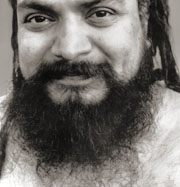Similes & Metaphors
The similes and metaphors in Yoga Vasishta are repetitive and seemingly endless. The author considers this a virtue: “What I will say, by opposite similes, right reasoning, graceful style, and good sense of the words in which they shall be conveyed to you, cannot fail to come to your heart.” (III.84.47) The modern reader will find the constant repetition often obscures the simple thought being expressed. But that repetition is part of how Yoga Vasishta impacts the reader.
We might mistake a rope for a snake until we examine more closely and realize our mistake. We mistake a desert mirage for water. Through a thin cloud layer we see a second moon. The appearance of phenomena is like waves on the ocean or like jewelry made out of gold. There is no difference in the substance (waves are water; jewelry is of gold), only the appearance. A crow lands on a coconut tree as a coconut simultaneously falls, so we mistakenly assume there is a cause-and-effect relationship. (This metaphor is frequently cited in Venkatesananda’s English abridgments, but it appears only twice in Mitra’s translation.) Reality is constantly compared to seeing a snake in a rope, water in a mirage, horns on a rabbit, castles in the sky, a barren woman’s son, and a double moon.
It seems that Vasishta is incapable of making a statement without a simile. “Whatever . . . compositions are adorned with measured sentences and graceful diction, all these are rendered acutely insightful through conspicuous comparisons, as the world is enlightened by cooling moonbeams. Therefore almost every verse in this work is embellished with a suitable comparison.” (III.84.47)
Ornate, baroque language may have been the fashion in medieval India, but it makes for a tough read for a modern reader. One wishes a modern day sage would re-write the book, using similes and metaphors more sparingly. Perhaps the modern sage could employ more modern metaphors, like movie projectors and screens, television programs, and computer clouds.
Like creation itself, Yoga Vasishta seems repetitive, sometimes irrelevant, and seemingly endless. But the only way to describe God is through simile and metaphor. There is no word or concept that can describe consciousness, God. “The soul being inexpressible in words proves to be described only in negative terms.” (V.34.101) “No conception of God can be true.” (VIA.49.24)
We are so habituated to believing our senses and desiring the things of this world that repetition and effort are necessary to become established in the truth. “The repetition of a lesson serves to impress it more deeply in the memory of inattentive persons.” (VIB.198.1) “But because the human mind is like a child, it must not be forced. The training of a child is like that of the mind. It is done slowly by gentleness and indulgence, and not by force or hurry.” (II.9.32-33)
As one reads what seems repetitive or irrelevant, the ideas and images become more deeply impressed in the mind. We realize it is true because it is who we are. As one reads, one argues with the book. As one re-reads, ideas occur. Realization happens.
So the length or complexity of the book ought not deter any of us. It is part of the process. The rewards are there.
![]()

